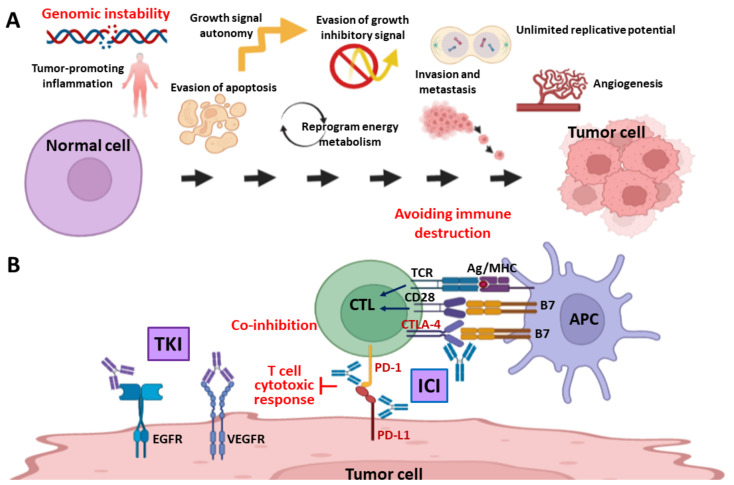Figure 1.
Cancer hallmarks, target therapy and immunotherapy. (A) Hallmarks and enabling characteristics of cancer. Hanahan and Weinberg propose six fundamental hallmarks (autonomous growth signal, evasion of growth inhibitory signal, evasion of apoptosis cell death, unlimited replicative potential, angiogenesis, and invasion and metastasis), two emerging hallmarks (reprogram energy metabolism and avoiding immune destruction), and two enabling characteristics (genomic instability and tumor-promoting inflammation) to distinguish cancer from normal cells. The genomic instability and avoiding immune destruction (in red) are the principal foundations of synthetic lethality and immune checkpoint blockade-based cancer therapy. (B) Target therapy and immunotherapy. (Left part) The epidermal growth factor receptor (EGFR) and vascular endothelial growth factor receptor (VEGFR) are the major targets of tyrosine kinase inhibitors (TKI), such as HerceptinTM (trastuzumab) and AvastinTM (Bevacizumab). (Right part) The CTLA-4, PD-1, and PD-L1 are immune checkpoint molecules (in red) for cancer immunotherapy. The immune checkpoint inhibitors (ICI) include ipilimumab (anti-CTLA-4 antibody), nivolumab and pembrolizumab (anti-PD-1 antibody), and atezolizumab, avelumab and durvalumab (anti-PD-L1 antibody). Ag, antigen. APC, antigen presenting cells. CTL, cytotoxic T lymphocyte. MHC, major histocompatibility complex. TCR, T-cell receptor. Graph created with Biorender.com.

